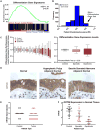Degree of Tissue Differentiation Dictates Susceptibility to BRAF-Driven Colorectal Cancer
- PMID: 29281831
- PMCID: PMC5747303
- DOI: 10.1016/j.celrep.2017.11.104
Degree of Tissue Differentiation Dictates Susceptibility to BRAF-Driven Colorectal Cancer
Abstract
Oncogenic mutations in BRAF are believed to initiate serrated colorectal cancers; however, the mechanisms of BRAF-driven colon cancer are unclear. We find that oncogenic BRAF paradoxically suppresses stem cell renewal and instead promotes differentiation. Correspondingly, tumor formation is inefficient in BRAF-driven mouse models of colon cancer. By reducing levels of differentiation via genetic manipulation of either of two distinct differentiation-promoting factors (Smad4 or Cdx2), stem cell activity is restored in BRAFV600E intestines, and the oncogenic capacity of BRAFV600E is amplified. In human patients, we observe that reduced levels of differentiation in normal tissue is associated with increased susceptibility to serrated colon tumors. Together, these findings help resolve the conditions necessary for BRAF-driven colon cancer initiation. Additionally, our results predict that genetic and/or environmental factors that reduce tissue differentiation will increase susceptibility to serrated colon cancer. These findings offer an opportunity to identify susceptible individuals by assessing their tissue-differentiation status.
Keywords: BRAF; Cdx2; Smad4; intestinal homeostasis; serrated colorectal cancer.
Copyright © 2017 The Author(s). Published by Elsevier Inc. All rights reserved.
Conflict of interest statement
The authors declare no conflicts of interest
Figures







References
-
- Barker N, Ridgway RA, van Es JH, van de Wetering M, Begthel H, van den Born M, Danenberg E, Clarke AR, Sansom OJ, Clevers H. Crypt stem cells as the cells-of-origin of intestinal cancer. Nature. 2009;457:608–611. - PubMed
-
- Barker N, van Es JH, Kuipers J, Kujala P, van den Born M, Cozijnsen M, Haegebarth A, Korving J, Begthel H, Peters PJ, et al. Identification of stem cells in small intestine and colon by marker gene Lgr5. Nature. 2007;449:1003–1007. - PubMed
Publication types
MeSH terms
Substances
Grants and funding
LinkOut - more resources
Full Text Sources
Other Literature Sources
Medical
Molecular Biology Databases
Research Materials
Miscellaneous

